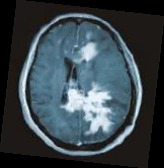Usted está aquí
Peruvian Journal of Neurosurgery
Primary central nervous system lymphoma: Case report
ABSTRACT
Primary central nervous system lymphoma (PCNSL) is a rare form of non-Hodgkin lymphoma (NHL) which affects brain, spinal cord, leptomeninges and eyes. Its clinical course and radiological features are different in inmunocompetent patients comparated with inmunocomprised patients, especially in patients with acquired inmunodeficiency syndrome (AIDS). The diagnosis should be followed for a detailed evaluation, including a carefully physical examination, ophthalmologic evaluation, a chest/abdomen/pelvis computed tomography (CT) scan, cerebrospinal fluid (CSF) analysis, human immuno deficiency virus (HIV) testing and a contrast enhanced brain magnetic resonance image (MRI). MRI usually shows one or more enhanced paraventricular lesions, deep in the white matter, spanning the corpus callosum. Stereotactic brain biopsy sampling is the gold standard for the diagnosis. The use of Metotrexate in high doses followed by radiotherapy has demonstrated the best results in the treatment of PCNSL. A 44 years old woman, with apparently spontaneous remission of multiple brain lesions demonstrated in MRI plus initial negative biopsy sampling for PCNSL, showed tumoral enlarging after a follow up of 2 years.



